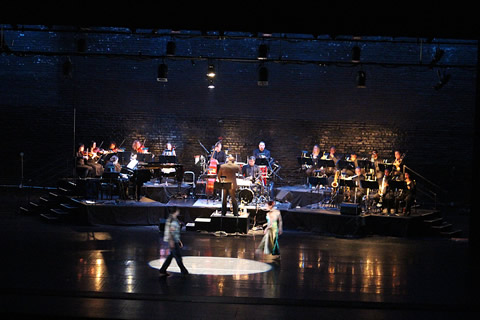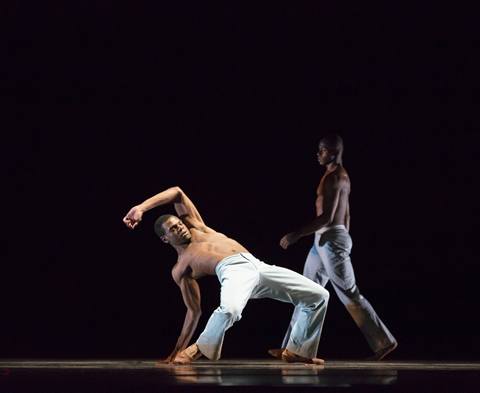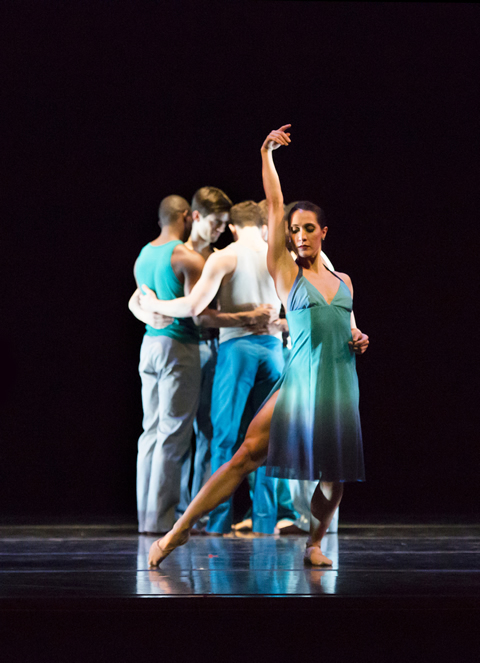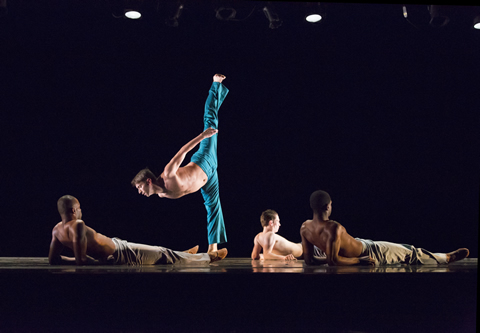Archivo
Lo Nuevo[hide]
Grupos: Ritmo Oriental : 1988 - Vol. IX - 30 a...
Musicos: Rafael Paseiro Monzón
Musicos: Dennis Nicles Cobas
Musicos: Jiovanni Cofiño Sánchez
Musicos: Yasser Morejón Pino
Fotos: Tom Ehrlich : 2024 Monterey Jazz, P...
Resenas: Vacilón Santiaguero (Circle 9 ...
Staff: Bill Tilford
Fotos: Tom Ehrlich : 2024 Monterey Jazz, P...
Fotos: Tom Ehrlich : 2024 Monterey Jazz Fe...
Fotos: Tom Ehrlich : testing 123
Grupos: Pupy y los que S... : Discography - 1995- F...
Reportes: From The St... : Cubadisco 2...
Reportes: From The St... : Jazz Plaza ...
Fotos Del Día [hide]
Sin Clave No Hay Na
Havana Blue
Auditorium Theatre, Chicago, 13 April 2013

(photo by Kent Richmond courtesy Chicago Jazz Philharmonic)
Orbert Davis of the Chicago Jazz Philharmonic and Frank Chaves of River North Dance Chicago had already performed diligent work managing expectations about what to expect and what not to expect from Havana Blue during interviews in the press and a roundtable discussion at the Instituto Cervantes leading up to the performance, so this writer went into the Auditorium Theatre understanding that this was to be an original interpretive work rather than a series of covers of Cuban music and dance, and he was prepared to receive the work on its own terms. Nevertheless, it is difficult for anyone who works with Cuban music to watch and listen to "Cuban-inspired" works without also considering the relationships that have unfolded for more than a century between Cuban performers and their American counterparts as well as Cuban and North American music, so this review will speak to both this performance and the bigger picture as well.

(Photo by Cheryl Mann courtesy Carol Fox & Associates)
According to both Mr. Chaves and Mr. Davis, the Artistic Directors for the work, this was a specially-commissioned suite that was first conceived at the Miles Davis Festival in 2011 and later infused with impressions gathered during an October 2012 trip to Cuba. Mr. Chaves was born in Cuba but left the island at the age of 6 months. For deeper background about the genesis of the piece, Howard Reich's articles in the Chicago Tribune are an excellent read.
The performance opened with a set of three pieces by elements of the Chicago Jazz Philharmonic sans dancers. The opening number, Chega de Saudade, is actually a Brazilian piece by Jobim, but in a way, this was appropriate since Mr. Davis had mentioned during the roundtable discussion at the Instituto Cervantes that one of the bands he encountered in Havana had been playing The Girl From Ipanema when he first met them. The second piece was a cha-cha jam that Orbert called Orlando's Walk, and the ensemble did get into the spirit of things with some (more or less) choreographed moves of its own. The introductory section closed with Dizzy Gillespie's Manteca, one of the early and enduring classics of Afro-Cuban Jazz in the United States. We'll say more about Dizzy's significance later on.
 The next segment of the performance was a tribute to the late chanteuse/guitarist Eva Cassidy by River North Dance Chicago using some of Eva's key recordings Fields of Gold, Stormy Monday, Autumn Leaves and Wade In The Water for the music. Although the suite caught this writer off guard, it turned out to be a pleasant surprise; the dance choreography was intense, and the presentation gave many listeners a new appreciation of the work Eva left before she passed. Much of this segment involved extended emotional interplay between couples. (Photo by Cheryl Mann courtesy Carol Fox & Associates)
The next segment of the performance was a tribute to the late chanteuse/guitarist Eva Cassidy by River North Dance Chicago using some of Eva's key recordings Fields of Gold, Stormy Monday, Autumn Leaves and Wade In The Water for the music. Although the suite caught this writer off guard, it turned out to be a pleasant surprise; the dance choreography was intense, and the presentation gave many listeners a new appreciation of the work Eva left before she passed. Much of this segment involved extended emotional interplay between couples. (Photo by Cheryl Mann courtesy Carol Fox & Associates)
 The entire Chicago Jazz Philharmonic and River North Dance Chicago ensembles came together for the final segment, Havana Blue. While the dancing was contemporary rather than folkloric, it was evocative of the emotions inspired by the visit to Cuba, beginning in a somewhat subdued fashion but building steadily to a climax thoughout the piece. One of the movements in the suite, Lo Masculino, showcased the more athletic side of the male dancers in the troupe. (Photo by Cheryl Mann courtesy Carol Fox & Associates)
The entire Chicago Jazz Philharmonic and River North Dance Chicago ensembles came together for the final segment, Havana Blue. While the dancing was contemporary rather than folkloric, it was evocative of the emotions inspired by the visit to Cuba, beginning in a somewhat subdued fashion but building steadily to a climax thoughout the piece. One of the movements in the suite, Lo Masculino, showcased the more athletic side of the male dancers in the troupe. (Photo by Cheryl Mann courtesy Carol Fox & Associates)
Mr. Davis may actually have worked too hard to downplay expectations regarding the Cuban elements of the work. One of the incidental musical interludes, Al Fin Te Vi, was a classic Ernesto Lecuona piece, and the other interlude, Canción de Polo Montañez, channeled the spirit of that renowned Cuban songwriter as well. The early movements in the piece provided some evidence that Mr. Davis, like any good student of this music, has apparently been exposed to the work of Cachao; as the prominent role of the bass and the phrasings used for the rest of the ensemble were reminiscent of the master. The powerful finale, Azul Vivo: Havana at 12, unleashed the full force of both the dancers and the musicians. The musical highlights included some beautiful solos by ubiquitous flautist Steve Eisen, trombonist Tracy Kirk and Orbert Davis himself.
Havana Blue was a beautiful suite (both as regards the music and the dance performance), and the evening was very enjoyable overall - this deserves an opportunity to be presented elsewhere at some point should all of the principals be so inclined. However, it was inevitable that our thoughts would also turn to the situation with Cuba's best musicians and dancers after watching a piece like this, and here are a couple observations that we would like to share:
1. The enthusiastic reception of this work by a packed Auditorium illustrates that there may be an untapped market for some of the best music from Cuba to come to Chicago. New York's Brooklyn Academy of Music presented a very successful Red Hot + Cuba show using many of Cuba's best current popular music artists last year, proving that it can be done if properly organized.
2. For better or worse, when Cuban musicians have acheived mass success (as opposed to playing for a cult following) in the United States during the past several decades, the assistance of a US or European "champion" has frequently been critical for that success. This is true both of immigrants and touring bands from Cuba. For example, on the immigrant side of the equation, Arturo Sandoval has openly and correctly credited the importance of Dizzy Gillespie's role in helping his own career. For the bands touring from Cuba, the Buena Vista Social Club movie phenomenon from Wim Wenders continues to assist the success of groups such as Juan De Marcos' Afro Cuban All Stars. There is a new generation of worthy Jazz and popular dance music artists in Cuba that would love a similar opportunity to excite US audiences, but the best of them await their own Wim Wenders or Dizzy Gillespie. We humbly suggest to those American musicians who have fallen in love with Cuban music and are incorporating it into their work that although there is no legal or business imperative to play that role, it would still be worthy of consideration should they ever meet the living musician(s) who catch their fancy to that degree. Not to mention, joint performances of the best US and Cuban musicians make for one hell of a show. Miami and New York are figuring this out. Chicago, New Orleans and other cities deserve a taste as well (and if you don't know where to find Cuba's musicians of that caliber, you know where to find us, and we do know where they are...).



















